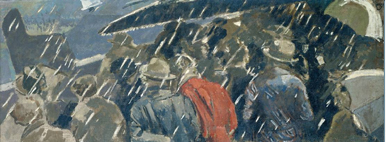“No one could be more English than I am,” Walter Richard Sickert proclaimed: “Born in Munich in 1860, of pure Danish descent!” Sickert’s ironic and self-consciously fluid sense of his own national identity was an integral part of his genius – which is abundantly in evidence in a small but beautifully selected exhibition of his works at the Abbot Hall Museum and Art Gallery in Kendal, in the Lake District. “Walter Richard Sickert: The Human Canvas” is in an unusual show, in that it is driven by no overt sense of art historical mission. It simply aims to reveal the breadth of Sickert’s abilities and the depth of his humanity; and it succeeds on both counts.
Having settled in London at the age of eight, Sickert conceived the ambition to become a painter during his teens, in the 1870s, at a particular inauspicious moment in the history of British art. Constable and Turner had been dead for decades; high Victorian painting veered between earnest sentimentality and a vapid, sensuous escapism; and the baton of innovative contemporary painting seemed to have passed, decisively, to France – to Monet and the Impressionists, to Degas, and to those who would follow in their footsteps. Almost alone of his generation, Sickert was brave enough, and sufficiently discontented with what passed for serious painting in London, to look elsewhere for his sources of inspiration. First of all he fell under the spell of the American émigré Whistler, the closest thing to a French painter working in London in the 1870s and 1880s, whose wistful, low-toned, atmospheric cityscapes and portraits were a lasting influence on him. Through Whistler, the aspiring young artist met Edgar Degas, from whom he absorbed the ambition of becoming what the French poet Charles Baudelaire had defined as a “painter of modern...

“Walter Richard Sickert: The Human Canvas”, at the Abbot Hall Museum and Art Gallery, Kendal 2004
01-08-2004

